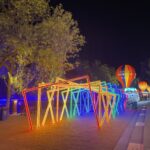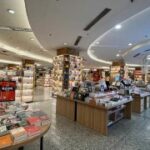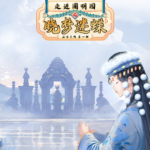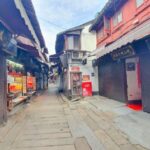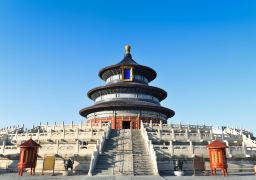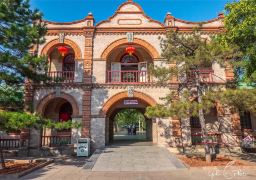Dàshílànr, located southwest of Tiananmen, is a renowned ancient marketplace and bustling commercial district in Beijing, epitomizing the city’s culture and essence. Within this district, shops for shopping, dining, and entertainment are densely packed, with various merchants lining the streets, making it an essential destination for entertainment, culinary exploration, and experiencing Beijing’s culture.
Dàshílànr Commercial Street: A Merchants’ Hub When visiting the Dàshílànr area, the commercial street is an excellent choice. Situated on the west side of Qianmen Street, it is a crucial part of the Qianmen business circle. As a commercial street with nearly 600 years of history, Dàshílànr has always been the center of commerce in old Beijing, home to many famous merchants such as Tong Ren Tang for traditional Chinese medicine, Rui Fu Xiang for silk and satin, Nei Lian Sheng for cloth shoes, and Liu Bi Ju for pickled vegetables. Ménkuàng Hutong: A Must-Visit for Food Lovers Dàshílànr’s numerous food shops should not be missed, especially if you are a food enthusiast. Ménkuàng Hutong, located in the northeastern part of Dàshílànr Street, runs north-south from Dàshílànr Street to Langfang Toutiao, intersecting with Langfang Ertiao and Santao, and was a famous snack street during the late Qing Dynasty and Republic of China period. Today, Ménkuàng Hutong offers a variety of snacks such as ‘Nian Gao Wang’, ‘Wan Dou Wan’, ‘Xian Bing Lu’, ‘Bao Du Yang’, ‘Dou Fu Nao Bai’, ‘Nai Lao Wei’, ‘Tong Yi Xuan Mutton’, and ‘Da Lian Huo Shao’, all at affordable prices. Yanshou Street: A Street Full of Life For those who appreciate the aroma of freshly prepared food, Yanshou Street is a must-visit. Filled with the scent of fried chicken, halal shops offering lamb and beef offal, pickled vegetables, and even pancakes, the street’s atmosphere is best described as rustic. After a satisfying meal, consider visiting the Kui De Society nearby to watch a ‘one-man show’ and experience life like a local Beijinger. Eight Big Hutongs: Experiencing the Rich Beijing Flavor If you wish to immerse yourself in the profound Beijing culture and history, the Eight Big Hutongs are an excellent choice. These refer to eight hutongs south of Tie Shu Xie Street, namely: Bai Shun Hutong, Yan Zhi Hutong, Han Jia Tan, Shan Xi Xiang, Shi Tou Hutong, Wang Guang Fu Xie Street, Zhu Jia Hutong, and Li Sha Mao Hutong. Established during the Qing Dynasty’s Qianlong period, the Eight Big Hutongs were home to the ‘Si Xi Ban’ opera troupe when the Hui opera troupes entered Beijing, and during the Republic of China period, the anti-Yuan protectorate courtesan Xiao Fengxian established the ‘Yun Ji Ban’ here.Strolling through the famous Bada Hutong, one can still sense the rich historical atmosphere. The Liulichang East Street in the Dashilar area is a must-visit for scholars and literati. This place was once a kiln factory for making colored glaze during the Yuan Dynasty. Nowadays, many merchants have set up calligraphy and paintings along the street, transforming it into a roadside gallery. Liulichang East Street has also become a hub for collecting calligraphy treasures and antiques. The area is open to the public all year round, with full-day accessibility.
